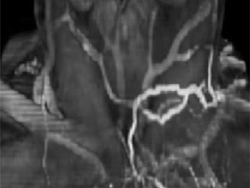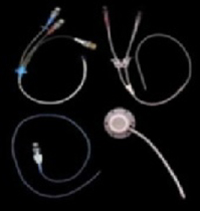CT image with IV contrast of the base of the neck showing thrombosed veins.
FIGURE 2 Collateral circulation

This 3D reconstruction of CT images shows the extensive collateral circulation on the left, compared with the right.
You caught it early
Suppurative thrombophlebitis. This problem often presents with fever and rigorous chills. Swelling and tenderness is noted over the affected vein in about half the cases. Obviously, though, inspection and palpation of the vena cava is challenging and such signs do not apply when these vessels are involved.
Respiratory distress due to septic pulmonary emboli and secondary pneumonia is common. Metastatic abscess formation at other sites, such as joint and bone, have been reported.1,6
You realize that most patients with suppurative thrombophlebitis present in a much more toxic state than yours did. Perhaps you caught it early. She certainly has risk factors, including her recent pharyngitis and central venous catheterization. The prominent collateral circulation raises the possibility that this may have developed subacutely, following a more indolent course than is generally reported.
The organisms responsible for suppurative thrombophlebitis depend on the infection’s site of origin. Most of the time in the peripheral veins or vena cava, Staphylococcus, a member of normal skin flora, is the pathogen. Streptococcus, Enterobacteriaceae, Candida, and even cytomegalovirus have been documented.4,7,8 Jugular septic thrombophlebitis draws from the oral flora, with the most common causative agent being the anaerobic Fusobacterium.
A thrombus provides an excellent source of nutrients for the microbes, which colonize it and establish what is essentially a biofilm. These complex microbial architectures are extraordinarily resistant to antibiotic therapy, especially when compared with plantonic bacteria.9 Not only does the thrombus facilitate the infection, but the bacteria facilitate thrombus formation by promoting platelet aggregation.10
A:
Chemotherapy is only one of the many circumstances in which central venous access is required. Central venous access devices (CVADs) are also used for administration of antibiotics, hydration, total parenteral nutrition, or long-term blood sampling.
The central lines that most family physicians learned to insert during residency are only one of a dizzying array of CVADs in use. The triple-lumen lines are inserted transcutaneously by the resident into either the jugular or subclavian veins and are good for short-to-medium duration therapies. They require diligent care to prevent occlusion or infection, including daily flushing.
For longer-duration therapies, tunneled catheters may be placed, typically by surgical consultants. These are less prone to bleeding or infection but still require diligent attention and regular flushing. Some models do permit weekly flushing.
Peripherally-inserted central venous catheters (PICCs) may be used for up to a year. Generally inserted by nursing staff, they are still fairly high-maintenance and require daily flushes.

Representative venous access devices. Clockwise from upper left: triple lumen catheter, tunneled catheter, subcutaneous port, PICC.
Your patient had a subcutaneous CVAD, which is often called a “port.” It is surgically implanted, not unlike a pacemaker, and is ideal for long-term use, especially when required access is intermittent. It requires flushing only monthly (weekly when being accessed).
Medication or surgery?
Because of its resistance to antibiotic treatment, peripheral venous suppurative thrombophlebitis is a surgical disease, not unlike an abscess, and requires excision or incision and drainage of the affected vessel. Antibiotics alone are inadequate. Excision of thrombophlebitis of the central veins affected is not feasible (though thrombectomies are occasionally undertaken). In this case, prolonged antibiotic therapy is indicated.
Anticoagulation may also be considered, though no strong evidence supports that addition. Given the effect of Fusobacterium on platelet aggregation, aspirin might be expected to provide benefit. In vitro studies show inhibition of this aggregation with aspirin,10 but no clinical studies or even case reports indicate improved outcomes with its use.
A hospital stay
Prolonged antibiotics
You admit the patient to the hospital with a presumptive diagnosis of Lemierre’s syndrome and begin piperacillin/tazobactam intravenously, covering both Fusobacterium and Staphlococcus. You also opt to begin heparin and resume her warfarin, more for her history of DVT than because of documented benefit of anticoagulation in the management of suppurative thrombophlebitis.
An awareness of potential complications is vital before undertaking any medical intervention. Although it would be unusual for a family physician to place a port, insertion of central venous lines is a commonly performed procedure that shares many of the same risks. fortunately, septic thrombophlebitis is a rare complication; unfortunately, a variety of other complications may occur. These include hemorrhage, venous thrombosis (uninfected), extravascular hematoma, local or systemic infection, pneumo- hydro- hemo- or chylo-thorax, air embolus, catheter fragment embolus, nerve injury, arteriovenous fistula, and cardiac arrhythmias or tamponade. The likelihood of complications from this procedure can be diminished by strict adherence to aseptic technique, and a thorough knowledge of the surrounding anatomy. Contraindications include distorted anatomy, suspected superior vena cava injury, compromise (such as pneumothorax on the side contralateral to the planned insertion site), infection or full-thickness burns at the planned insertion site, and coagulopathy.
—Mark Huntington, MD

